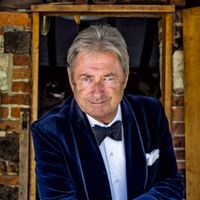Alan Titchmarsh: I went a bit mad ordering bulbs — and I'm not even a little bit sorry I did
Our columnist's splurge in the autumn is now paying off with spectacular irises across his garden.


A monk I used to know — tall, slender, bearded and bespectacled with a fine line in asceticism — used to refer frequently to what he called ‘the postponement of gratification’. Being a monk it was, I suppose, understandable. He led a life devoted to prayer — the gratification being that offered when he was called to Heaven.
As a gardener, I could sympathise. I am, after all, planting things that take time to mature. Patience is needed as seeds grow into towering trees, but with bulbs the postponement of gratification is minimal.
Back in October — barely four months ago — I went a bit mad and ordered quite a lot of dwarf iris bulbs. I potted them up into terracotta pans of gritty compost. There were moments — as I was carrying them to a long, aluminium-alloy cold frame erected along the side of a barn — when I thought I might have overdone it. Altogether, I found I had filled 36 containers, some of them 12in in diameter, others barely 4in. The smaller ones took five or six bulbs, the larger ones 20. Throughout those variable winter months of heavy rainfall and intermittent freezing and thawing, the unheated covering — ventilated at all times — offered them no protection from low temperatures, but welcome respite from waterlogging.
By late November, slender, translucent spikes of growth began to emerge from the compost. By December, they resembled miniature versions of London’s Shard. And now… my moment of gratification has arrived and I am not at all sorry that I was profligate in my spending. Winter can be a dreary time for gardeners and the sooner spring comes — courtesy of bulbs, at first — the more relieved and joyful we are that life is returning to our patches of cold, wet earth.
Snowdrops are the first to brave the chilly weather, but dwarf irises are hard on their heels, together with the first narcissi. Nothing is more obviously uplifting than ‘a host of golden daffodils’, but if you want the class act of the spring-bulb world, look to the hybrids of Iris reticulata and I. histrioides. And I mean look. They repay close examination, which is why, in the main, we grow them in pots that can be lifted closer to eye level, where their intricate markings can be more readily observed.
The Reticulata hybrids (fragrant when temperatures rise sufficiently) are about 8in and rather taller than those of Iris histrioides, which manage 1½in or 4in. Plant them both in the garden and the fact that the latter is more vertically challenged means that it is more prone to mud splashing. Grow both of them in pots — topped with a thin layer of fine gravel — and this is not a problem.
"It leaves those who see it for the first time in awe of its beauty"
Patrick Synge in his Collins Guide to Bulbs, published in 1961 and still regularly pulled down from my bookshelf, tells us that Iris reticulata hails from ‘Russia, Caucasus and Northern Persia’, whereas I. histrioides is to be found in the wild in ‘Asia Minor, Turkey and N.W. Persia’. Persia is now Iran, but how many of us know where Asia Minor is? Or was? The answer is Anatolia. Where is Anatolia? Turkey.
Exquisite houses, the beauty of Nature, and how to get the most from your life, straight to your inbox.
Happily, many of them will grow in well-drained soil at the front of a border here in the UK, provided you remember where they are in summer when they have died down. The narrow leaves extend as the flowers fade. Plant the bulbs 3in apart in holes 3in deep. The more robust varieties will spread over the years, but, after flowering, the bulbs break down into a smaller cluster and take time to reach flowering size once more.
The flowers may be any shade of blue, from palest sapphire to deepest cobalt, and varieties such as ‘J.S. Dijt’ and ‘Pauline’ are a rich purple, the former with white markings on the fall petals and the latter decorated with bright yellow.
Perhaps the most mouthwatering of all is the variety ‘Katharine Hodgkin’, a hybrid between Iris winogradowii and I. histrioides raised in 1958 by that late great plantsman E. B. Anderson and named after the wife of the painter Eliot Hodgkin, who was herself a botanical artist. She cannot have been disappointed in her namesake, which is palest blue, etched with dark blue and blotched with yellow. It leaves those who see it for the first time in awe of its beauty. Delicate she may appear, but the clump that was growing in this garden when we moved in more than 20 years ago still thrives. I love her.
Chatsworth: The gardens and the people who made them by Alan Titchmarsh (Ebury, £35) is out now
Alan Titchmarsh is a gardener, writer, novelist and broadcaster.
